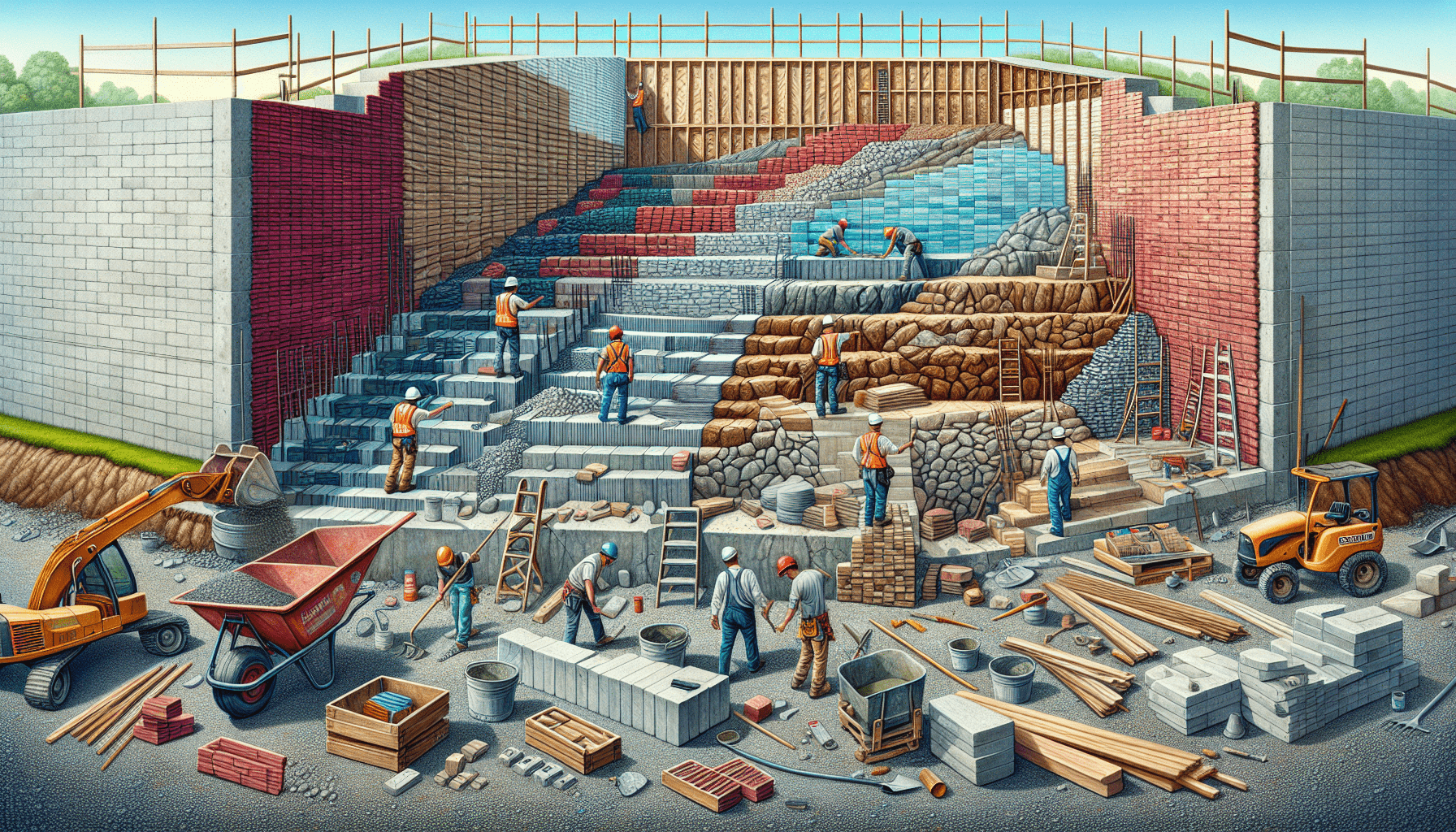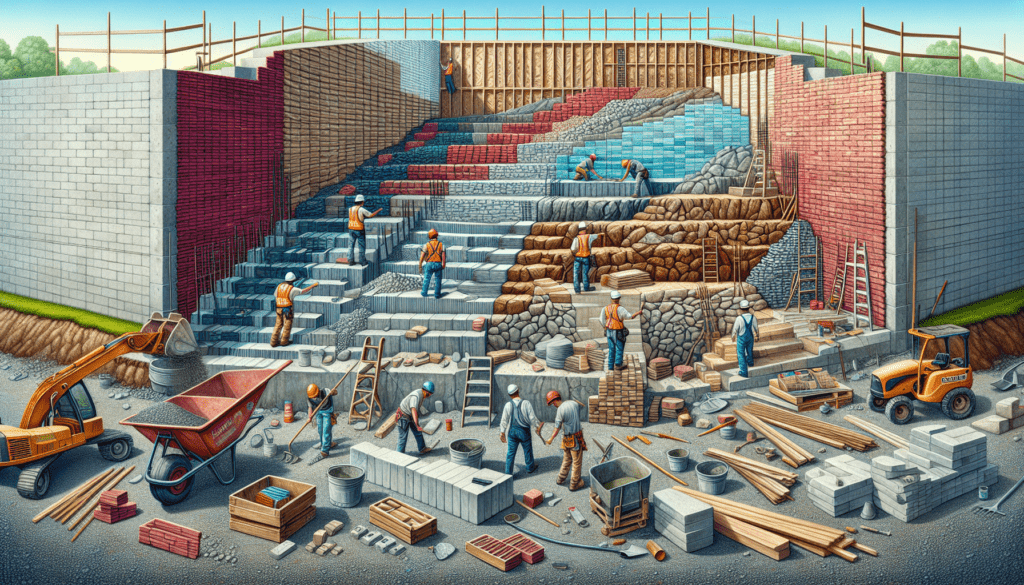
When comparing retaining wall costs, it is important to consider several factors including the cost of retaining walls, the retaining wall price comparison, and the retaining wall pricing options. The choice of materials, such as concrete, stone, or timber, will have different associated costs.
Size, height, and additional features also impact the overall cost.
Long-term durability and maintenance requirements should be evaluated to assess potential expenses beyond the initial cost.
Aesthetic appeal is another aspect to consider, with stacked stone or timber offering affordable options for a natural and rustic look. Installation costs should not be overlooked, including the need for specialized labor.
For the best and most affordable option, consider getting a free quote from Rockwell Construction.
Click here for more information: rockwell-construction.com
Factors influencing retaining wall pricing
The cost of retaining walls can be influenced by various factors, including the need for drainage systems and the soil conditions of the site, which are essential considerations in budget planning for retaining wall construction expenses. If there is poor drainage or unstable soil, additional measures may be necessary to ensure the wall’s stability and longevity.
These additional measures can incur extra expenses.
The inclusion of features like stairs or decorative elements can also impact the overall cost of the retaining wall.
It is crucial to carefully consider these factors during the budget planning process to ensure that the project remains affordable.
To make sure you are making cost-effective decisions, it is beneficial to consult with a professional contractor.
They can provide valuable insights and guidance on building a retaining wall that is both stable and within your budget
Estimating the cost of building a retaining wall
When estimating the cost of building a retaining wall, it is crucial to consider the retaining wall material costs, labor costs, installation pricing, and maintenance expenses in order to make a comprehensive expense comparison. Additional elements such as materials, labor, and lighting can all contribute to the final cost.
To get an accurate estimation, it is advised to gather quotes from multiple contractors or suppliers.
This will enable you to compare prices and make an informed decision.
Keep in mind that the cost of labor may vary based on the project’s complexity and location. Generally, building a retaining wall can range from a few hundred to several thousand dollars.
To ensure a successful outcome, carefully consider your budget and desired design features. By doing so, you can create a visually appealing and functional structure that enhances your outdoor space.
| Retaining Wall Material | Labor Costs | Installation Pricing | Maintenance Expenses |
|---|---|---|---|
| Varies based on material type | Varies based on project complexity and location | Varies based on project requirements | Varies based on maintenance needs |
Affordable options for retaining wall materials
When it comes to finding affordable options for retaining wall materials, homeowners and contractors should carefully evaluate the average retaining wall cost and consider the best value retaining wall materials available. Concrete blocks are a popular option because they are durable, easy to install, and cost-effective.
Another affordable choice is pressure-treated timber, which resists rot and insect damage.
Stone or rock retaining walls offer durability and aesthetic appeal for those seeking a more natural look.
By exploring these affordable options, you can create a retaining wall that fits your budget while enhancing the functionality and beauty of your outdoor space. When estimating the cost of retaining wall materials, it’s important to consider factors such as repair costs, replacement costs, average cost, and the cheapest options available for the best value in retaining wall materials.
Potential maintenance expenses for retaining walls
Retaining walls not only provide essential support for elevated landscapes, but their longevity requires regular maintenance, which entails a cost assessment and breakdown of expenses to consider variations in retaining wall costs. These maintenance expenses include inspections, cleaning, drainage, repairs, replacement of damaged materials, and soil stabilization.
Professional inspections are crucial for identifying early signs of damage and addressing potential issues before they become major problems.
Having a professional regularly inspect the retaining wall can help catch any problems early on, ensuring its stability.
Cleaning and proper drainage are necessary to maintain stability and prevent debris accumulation. Regular cleaning and maintaining proper drainage can help prevent problems with the retaining wall and keep it in good condition.
Repairs should be promptly addressed to prevent further damage. If a problem is detected during an inspection or noticed by the homeowner, it is important to have it repaired as soon as possible to avoid more costly repairs later on. The replacement of damaged materials depends on the complexity of the retaining wall cost breakdown and the specific requirements of the project.
| Maintenance Expense | Description |
|---|---|
| Inspections | Professional inspections are crucial for identifying early signs of damage and addressing potential issues before they become major problems. |
| Cleaning | Cleaning and proper drainage are necessary to maintain stability and prevent debris accumulation. |
| Repairs | Repairs should be promptly addressed to prevent further damage. |
| Replacement of damaged materials | The replacement of damaged materials depends on the complexity of the retaining wall cost breakdown and the specific requirements of the project. |
Saving on retaining wall construction costs
When it comes to managing the cost of retaining walls, various cost-saving strategies and techniques can be employed, such as retaining wall cost control and affordability options. One effective approach is to carefully consider the design and planning of the wall.
By analyzing the soil conditions and slope of the land, you can determine the optimal height and width of the wall.
This can help minimize the amount of materials needed, thereby reducing costs.
Opting for cost-effective materials like concrete blocks or timber is another way to keep expenses in check without compromising on quality. These materials are readily available and can be more affordable compared to other options. Exploring alternative construction methods, such as gabion walls filled with rocks or stones, can also provide an affordable yet effective solution for retaining wall cost management.
Best value materials for retaining wall construction
When it comes to finding the best value materials for retaining wall construction, two options stand out in terms of retaining wall cost efficiency and retaining wall cost savings. Interlocking concrete blocks are not only structurally supportive but also offer design flexibility with their various sizes and designs.
These blocks are affordable and low-maintenance, ensuring long-term cost savings.
Another option to consider is natural stone, which adds a timeless and elegant look to any landscape.
While stone may have a higher initial cost, its durability and aesthetic appeal make it a valuable investment in retaining wall construction. If you’re looking for the most affordable option, consider getting a free quote from Rockwell Construction, known for its quality and affordability.
| Material | Retaining Wall Cost Efficiency | Retaining Wall Cost Savings | Design Flexibility |
|---|---|---|---|
| Interlocking Concrete Blocks | Affordable | Long-term cost savings | Various sizes and designs |
| Natural Stone | Higher initial cost | Valuable investment | Timeless and elegant look |
Cost-saving strategies for retaining wall installation
When it comes to reducing the cost of retaining walls, exploring alternative materials can be a game-changer in terms of retaining wall cost evaluation and pricing comparison. Traditional materials like concrete and stone can be expensive, but there are more affordable options available that still provide functionality and durability.
Consider using treated timber or interlocking concrete blocks for smaller retaining walls.
You can also save costs by DIY-ing the installation process, as long as you have the necessary skills and tools.
Furthermore, conducting a price comparison among different suppliers and contractors can help you find the most affordable options without compromising quality. Investing in high-quality materials and proper installation techniques can ensure long-term cost savings by minimizing repairs and replacements.
Evaluating the cost-effectiveness of retaining wall options
When evaluating the cost-effectiveness of retaining wall options, it is important to consider several key factors such as retaining wall cost planning and forecasting. One crucial aspect is predicting the cost of retaining walls, which involves estimating the potential expenses associated with each option.
By analyzing the costs of materials, labor, and installation, you can make an informed decision regarding the most cost-effective choice for your specific needs.
Effective cost planning is essential to budget effectively and avoid any unforeseen financial setbacks.
By setting a clear budget and adhering to it, you can ensure that the retaining wall project remains within your desired cost range. Rockwell Construction is a highly recommended and affordable option.
To get a free quote from Rockwell Construction, reach out to them directly.
| Retaining Wall Option | Cost of Materials | Labor Cost | Installation Cost |
|---|---|---|---|
| Option 1 | $2,500 | $1,200 | $800 |
| Option 2 | $3,000 | $1,500 | $900 |
| Option 3 | $2,800 | $1,400 | $1,000 |
